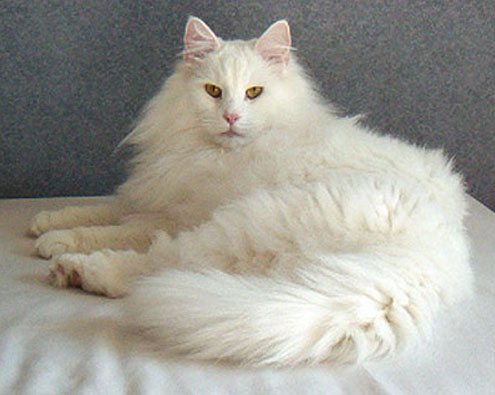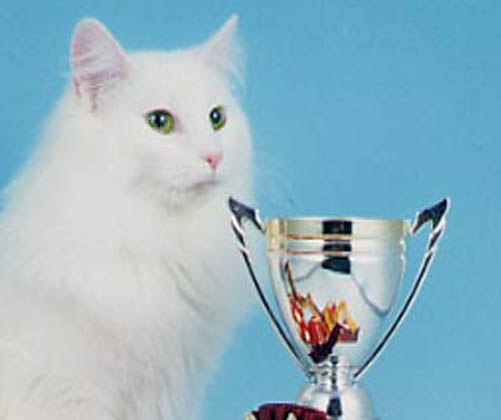
ZZZZZZZZzzzzzzzzzzzzzzz........ So, please 'scuse my grubby paws but I have been playing hard as you can
probably tell.
But I have a riddle for you:
Can you guess what colour my eyes are?
????
I'll let you know when I wake up......
Meanwhile just so you know - White cats can have many diffrent eye colours.
Here are a few to see. Don't you just love the kind of blue eyes you can drown in,
as my housemate has here:

Or do you prefer the eye colour of her littermate, a handsome bloke if you ask me, with his orange eyes. You may have seen orange eyes in white cats more often than the other colours as in some breeds they specially select for orange and not any other colours. But in this Norwegian Forest Cat breed, we appreciate the beauty of all the colours, and they have equal value in the show hall:

The third main eye colour in white cats is green. Green eyes are found only in some breeds because of the tendency in
many of the breeds, to select orange.
Little genes called polygenes decide whether the cat will have a little pigment for eye colour (which makes
green) or a lot of pigment for eye colour (which makes orange) or somewhere in-between (which makes yellow).
Depending what polygenes there are in the parents, the kittens can arrive with different combinations of the
parents' polygenes, and you may get different eye colours in the same litter unless both parents have much the
same polygenes for pigment intensity. How do you like these green eyes:

So where in the green-orange pigment spectrum do we find blue eyes in white cats?
The answer is that blue is not from the normal eye colour genes. It results as an overflow activity of the genes
for white fur. What happens is that the genes for white fur, implement during
embryology, and they *prevent* pigment granules called melanocytes from migrating to the fur. Of course
if there are no pigmnet granules in the fur to hold colouring pigment, the fur will have no colour and be white.
Well the genes for white can also affect the eyes. If they send no pigment granules to the eyes, the eyes
will appear blue. Sometimes they prevent pigment from reaching just one eye (and very occasionally even just half an eye).
So it quite often happens that a cat with one or more genes for white will have one or two blue eyes.
A cat with one eye blue and the other eye coloured according to the usual genes, (orange or green or yellow) is called an odd-eye cat.
Here's my dad, who is an odd-eyed white cat with one blue eye and one green eye:

Well, now I have a surprise for you. There is more than one gene in cats which makes white fur.
So far the "dominant white" gene was the cause of the all-white cats above. It's abbreviated W by geneticists.
W for white cat. There is the other white fur gene which does not usually make the whole cat white,
but may affect only a few hairs, or white feet or a half-white cat, or an almost all white cat.
The way the pigment granules work is the same with this partial white "spotting gene"
abbreviated S, as it is with the W gene.
In the Norwegian forest Cat breed, the cat is allowed to have as much or as little white as nature suggests .
The fun thing is that this white gene can also cause odd eyes by preventing pigment granules from reaching an eye
during embryology. Here's an example of an odd-eye cat with one orange and one blue eye, who is not all
white. He just has a white bib:

Now if that didn't impress you enough, I suspect I may really knock your socks off with this one.
She's a tortie tabbie and white girl
with odd eyes, this time one blue eye and one green eye.
Cats have to have white fur somewhere for the odd eyes to happen as it's the action of the removal of
pigment cells by the white gene that causes them! This girl has so little white, it's not really visible in the photo:

As you can see from the cat above, different genes decide *where* the pigment will be missing, such as one eye and a toe, from those that decide *how much* pigment will be missing such as an all white cat versus the one above.
As more evidence for inheritance of *where* the blue eye or deaf gene will be located, you can see that it runs
in families, and is passed on from parents as above, to offspring, as below. The kitten below has the above kitten as its mother.
As is typical, BOTH have the blue eye on the same side. The polygenes for position make it happen that way.
They are polygenes for the position of pigment or no pigment for eye colour.

If you are interested in the issue of deafness in cats with all white or some white fur, please read the next paragraphs, otherwise please feel free to scroll to the last picture.
Just in the same way as for eyes, polygenes will say whether an ear is deaf, and which ear is deaf or whether both will be deaf.
The point is that this is not random,
it is determined by polygenes. Anything determined by polygenes, however invisible (such as ear deafness) is at least
something we can strive to select for or against in the cat fancy. What we really need to do is to recognize that
this position of blue eye and/or deafness, is indeed NOT random - but caused by polygenes. It is only if we accept this,
that people will start to select using the non-random inheritance. Current trend is to pretend it is all random,
or to pretend deafness is associated with blue eyes or white fur. That would be a mistake, because although
there is a statistical connection, we can select against deafness and against blue and against odd eyes, - or if
we prefer we can select for odd eyes, for blue eye. There is an option to SELECT and in my opinion this should
not be ignored and we should
select against deafness.
If anything cats with blue eyes who are NOT deaf, are ideal breeding cats as they have "separated" the polygenes
for position of deafness for those concerning position of blue eyes. In fact any cat who is not deaf, is a good breeding cat
to use to select against deafness - but *separately* from any selection for or against blue eyes. We should stop
confusing the two. They are separate entities as shown here, inherited as to position and chance of occurrence
- separately, with separate polygenes. We need to know that selecting against deafness is what counts in eliminating deafness, it's all tha counts - and
that we can forget about whiteness or eye colour as a way to eliminate deafness. Deafness alone needs to be selected against.
The late Rusty Human, a persian breeder in South Africa who specialized in whites and blues, told me her statistics
for use in an article in my magazine PawPrint - which article was not published, but here are the statistics:
Over 23 years, Rusy bred 500 white cats, of which 6 were deaf. Her selection criterion was ONLY deafness.
If the cat was deaf, it was eliminated from the breeding program. No more no less.
With selection done on a confusion of blue eyes, or white fur combined with mere non-deaf selection, the results
are less predictable. That does not surprise me, as it seems from all the evidence that deafness alone has its own
polygenes for position of pigment loss. They are in no way *linked* with where the white fur does or does not occur,
nor where the blue eyes do or do not occur.
There is indeed more deafness in general in blue-eyed white cats than in those with other-colour eyes, but there
is no evidence that there is a link between blue eyes and deafness. Indeed you often get an odd-eyed cat who is
deaf on the coloured eye side, and hearing on the blue eye side.
You also get hearing blue-eyed cats - and non-hearing orange-eyed cats. All this is well known,
and further proves that there is no POSITION link between where the pigment of ears will be missing,
and where the pigment of eye or fur will be missing.
Certainly all the odd-eye cats with high colour show that the fur lack of pigment is quite unrelated to the eye lack of pigment.
Deaf cats with high fur colour and little white are rare but exist too.
The evidence is fairly obvious and before our eyes, to show separation of inheritance for the *position* of missing pigment - for *where* pigment is missing in fur to make it white, for *where* pigment is missing to make eyes blue or even partly blue in some cases; and for *where* pigment is missing to make ears deaf. (Yes, it is lack of pigment that makes ears deaf.) This separation of polygenes affecting where as opposed to how much pigment reduction there is, will gradually allow breeders to select cats for breeding with even less incidence of hearing reduction than there is now in pedigreed cats, while still being able to select for all the beautiful eye colours shown here.
Now - as I promised, since I'm awake now - here's *my* eye colour. Surprise!!! As you saw my dad has one blue and one green eye, but guess what, I have two orange eyes:

Am I deaf?
Well, that depends.....
If someone calls out that there's food, then I can hear just fine thanks..
Did you say Shrimp?
....NOT play in the mud before a show? .......Um...no mum, really, I didn't hear that!
Thank you to all those who kindly gave permission to use the photogaphs on this page.
Please note they are all copyright so don't copy them or download them....
......Tell people where to look instead!
OR Send me an email: